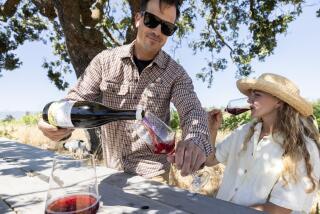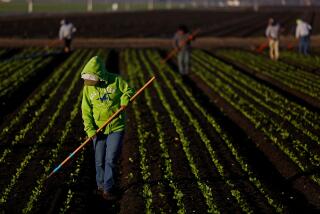Good Food Is Key to Healthy Crop of Kids
- Share via
During the holiday season, the spirit of giving spreads to many. It is during the rest of the year that many organizations struggle to sustain that spirit. When there is a clear vision of what the giving will accomplish, it becomes much easier to support and donate in a true spirit of charity.
As a fruit and vegetable farmer, I always have noticed that there are certain truths that occur in my fields that can be offered as analogies to life in general. It is clear that if I plant celery or green beans in a field on a given date I can expect to harvest each after a predictable period of growth and maturity. The seeds or transplants are all bred for uniformity and vigor. My responsibility is to provide these young plants with the best environment, fertilizer, nutrition and cultural care possible.
A field is not like a greenhouse, not like a factory. Invariably there are plants on the edge of a field or garden that, despite our best efforts, seem to miss out on the inputs, care and attention that we invest in our crop. Not surprisingly, these plants never seem to thrive and reach their full potential when it is time to harvest. They grow abnormally and become stunted. Their lack of vigor and immunity makes them more vulnerable to all kinds of pests and diseases.
I offer this simple analogy. How can children be any different from the plants and animals that a farmer or a gardener raises? A child who eats a doughnut and soft drink every morning, a fruitless fruit punch and cookie for lunch and some poor excuse for a dinner, day after day has a bad fertilizer program. If we raise a generation of children who miss out on so many of the critical components to a productive, thriving life, then what excuse can we give?
As a farmer I know my limitations and the consequences of failing to properly care for my crops. I can tolerate a 5%-to-10% failure rate in my fields. But in terms of human failures, what percent of a dysfunctional, malnourished population is acceptable? Aggressive behavior, attention-deficit syndrome, immune system abnormalities, learning disabilities--what role does nutrition deficiency play?
Our greatest fear should be that we are raising generation after generation of humans who never will reach their full potential because of our nutritional neglect and ignorance. And as a farmer will discard or destroy those plants or animals that don’t make the grade, our society stands idly by as we turn our backs on those who are struggling and not thriving. We are just now realizing the consequences of failing to care for our most valuable resource: our children.
Of course, it doesn’t have to be that way. Second Harvest Food Bank of Orange County, serving more than 350 local charities and 180,000 individuals in need, lately has placed a greater focus on improving the nutrient quality and quantity of its fresh fruit and vegetable supplies. The Orange County Harvest, one of the food bank’s programs, has been extremely successful. Every week this program brings together hundreds of volunteers to plant, weed, harvest and glean thousands of pounds of fresh produce for Orange County’s needy. The value to the community is far greater than most people can comprehend. Perhaps it is because of my day-to-day contact with agriculture that I can see the importance that these programs have in educating the urban public about some of the simplest and most profound lessons of life.
I am encouraged to think that new partnerships and paradigms will help us to move in a positive, decisive direction. At Second Harvest Food Bank, agriculture, nutrition and education are not three mutually exclusive areas. They can merge into a relationship that takes full advantage of each other’s resources. The Kids Cafe, the Mobile Food Pantry, the Orange County Fair’s Centennial Farm, the Orange County Farm Bureau’s Cornucopia Project, the Incredible Edible Park, the Water Works Project and El Modeno Gardens are agriculture and nutrition programs that serve the needy in Southern California. We are creating gardens in schools and parks that can become the cornerstone of a new awareness and vision for our society of the importance of nutritional abundance.
I believe that the creation of nutritional abundance is the highest, most achievable goal we can work toward. It lays the foundation for all other human endeavors. It may be the difference between living and thriving.
Now, I encourage you to do what you can to help. Whether you volunteer to glean in a local field, or donate food or funds to support these programs, you’ll ultimately help children, families and seniors to live healthier and more productive lives.






